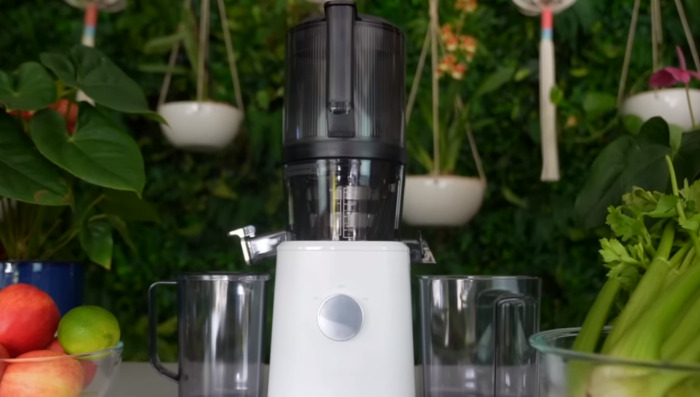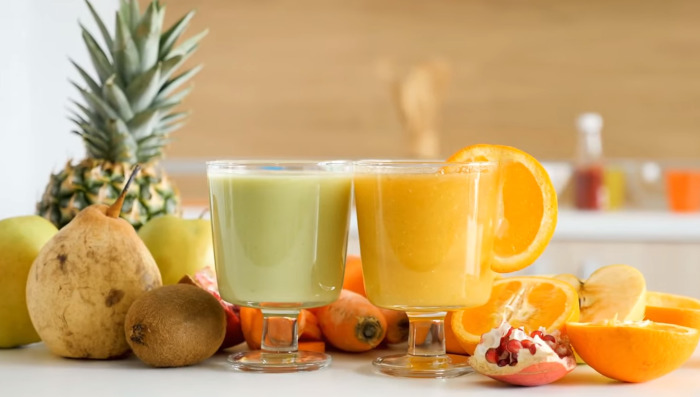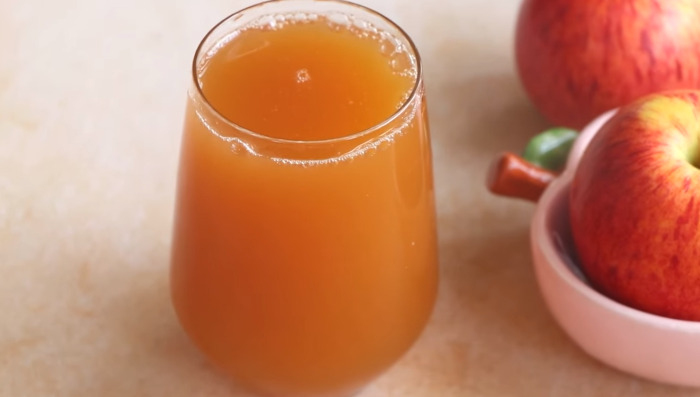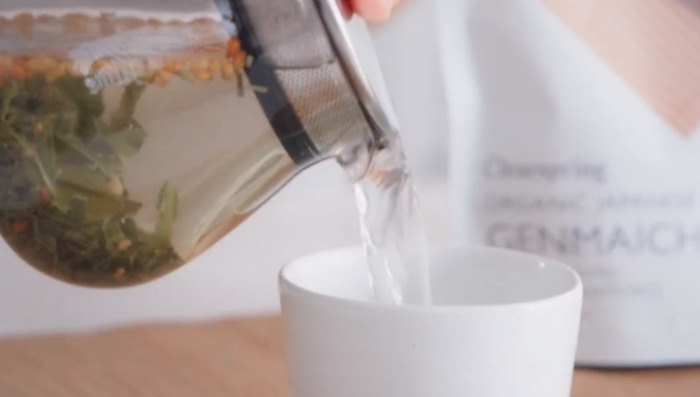Juicing has become a popular trend in the health and wellness community, but there’s often confusion surrounding the topic, especially when it comes to fiber. As an expert in this field, I’m here to clear up any misconceptions and provide you with accurate information.
First, let’s understand what juicing is. Juicing is the process of extracting the liquid part of fruits and vegetables, leaving behind the pulp, which contains insoluble fiber. This doesn’t mean that all fiber is lost; soluble fiber remains in the juice, providing some of the benefits associated with fiber intake.
However, juicing has its risks, such as the loss of insoluble fiber, lack of protein, and potential increase in sugar intake. It’s essential to balance juicing with a diet rich in whole fruits, vegetables, and other fiber sources.
In this article, we’ll delve into the role of fiber in juicing, common misconceptions, and how to create high-fiber juice. Whether you’re a juicing enthusiast or just curious about the subject, this guide will provide you with the insights you need, backed by facts and first-hand expertise.
Definition of Fiber
Fiber is a crucial part of our diet, found only in plant foods. It’s divided into two main types: soluble and insoluble. Soluble fiber dissolves in water, forming a gel-like substance that can absorb cholesterol and act as a prebiotic for beneficial intestinal bacteria. Insoluble fiber, on the other hand, doesn’t dissolve in water. It adds bulk to digestion, aiding in regular bowel movements.
Both types are essential for overall health, including reducing risks for type 2 diabetes, cardiovascular disease, and colon cancer. While juicing removes insoluble fiber, the soluble part remains in the juice, still offering some health benefits. Understanding this distinction is key to making informed decisions about your diet and juicing habits.
Equipment for Making High Fiber Juice:
Whether you’re aiming for a juice rich in soluble fiber or a smoothie full of whole plant goodness, these tools will help you achieve the desired results.
- Cold Press Juicer: Preserves more fiber, especially soluble fiber, by slowly pressing the fruits and vegetables without generating heat.
- Centrifugal Juicer: Faster but may lose some fiber content due to high-speed spinning blades.
- Blender: Suitable for making smoothies with whole fruits and vegetables, retaining both soluble and insoluble fiber.
- Hand-Juicer: Great for citrus fruits, allows more pulp through, increasing the soluble fiber in the juice.

- Strainers: Available in different coarseness levels, helps in controlling the amount of pulp or insoluble fiber in the juice.
- Mixing Spoons: For mixing in additional fiber sources like ground flaxseeds.
- Glass or Pitcher: For serving and storing the juice, ensuring that the fiber content remains intact.
- Measuring Cups and Spoons: For accurate measurements of ingredients, ensuring a balanced fiber content.
3 Best High-Fiber Juice Recipes:
1: Spinach Cucumber Juice
Ingredients:
- Spinach: 2 cups, fresh and washed
- Cucumber: 1 large, peeled and sliced
- Lemon: Juice of 1 lemon, freshly squeezed
- Apple: 1 medium, cored and sliced
- Ginger: 1-inch piece, peeled and grated
- Water: 1 cup, cold
- Ice Cubes: 5-6 (optional, for serving)
- Chia Seeds: 1 tablespoon (optional, for added fiber)
These ingredients combine to create a refreshing and nutritious juice, rich in soluble fiber and essential vitamins. The addition of chia seeds can enhance the fiber content, making it a great option for those looking to increase their daily intake.
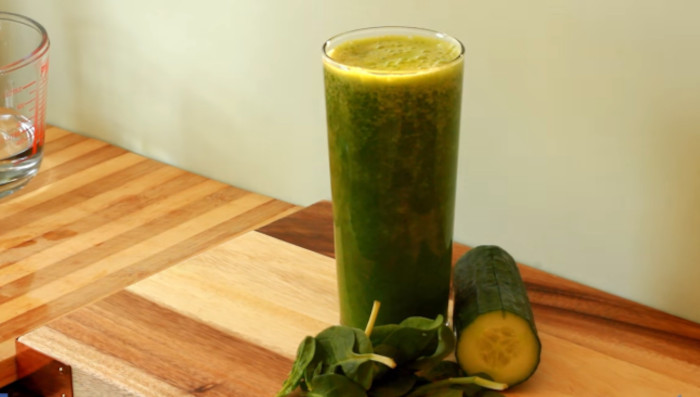
Instructions:
These simple steps create a refreshing and nutritious Spinach Cucumber Juice that’s perfect for a quick boost of energy and hydration.
- Prepare Ingredients: Wash and chop the spinach, cucumber, and apple. Peel and grate the ginger.
- Juice the Lemon: Cut the lemon in half and squeeze the juice into a bowl.
- Blend Ingredients: In a blender, combine the spinach, cucumber, apple, ginger, lemon juice, and water. Blend until smooth.
- Strain (Optional): If you prefer a smoother texture, strain the juice through a fine-mesh strainer.
- Add Chia Seeds: If using, stir in the chia seeds and allow them to soak for a few minutes.
- Serve with Ice: Pour the juice into glasses over ice cubes, if desired.
- Enjoy Immediately: Drink the juice right away to enjoy the maximum nutritional benefits, including the soluble fiber content.
2. Kale Green Juice
These ingredients combine to create a vibrant green juice that’s packed with vitamins, minerals, and soluble fiber.
Ingredients
- Kale: 5 large leaves, stems removed
- Green Apples: 2, cored and sliced
- Cucumber: 1 medium, peeled and sliced
- Celery Stalks: 3, chopped
- Lemon: 1, peeled and seeded
- Ginger Root: 1-inch piece, peeled and grated
- Mint Leaves: A handful, for freshness
- Water: 1 cup, to adjust consistency
- Chia Seeds (Optional): 1 tablespoon, for added fiber
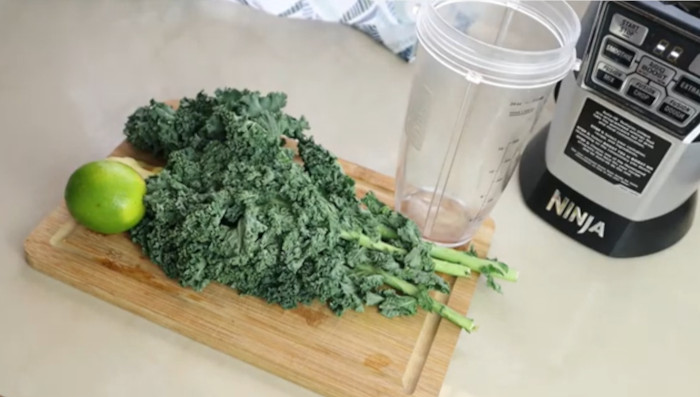
Instructions:
These simple steps will guide you in creating a refreshing and nutritious Kale Green Juice.
- Wash Ingredients: Thoroughly wash the kale, apples, cucumber, celery, lemon, and mint leaves.
- Prep Ingredients: Remove stems from kale, core and slice apples, peel and slice cucumber, chop celery, peel and seed lemon, and grate ginger.
- Start Juicing: Place the kale, apples, cucumber, celery, lemon, ginger, and mint leaves into a juicer.
- Add Water: If the juice is too thick, add water to reach your desired consistency.
- Optional Chia Seeds: If using, stir in chia seeds for added texture and fiber.
- Taste and Adjust: Taste the juice and adjust the flavor as needed, adding more lemon for tanginess or ginger for spice.
- Serve Chilled: Pour the juice into glasses and serve chilled or over ice.
- Enjoy Fresh: Enjoy immediately for the best flavor and nutrient content.
Related Read: Juicing Bitter Melon: A Complete Guide!
3: Red Cabbage Juice
Ingredients:
Here are the ingredients for making Red Cabbage Juice:
- Red Cabbage: 1/2 medium-sized head, washed and chopped
- Apples: 2 medium-sized, cored and sliced
- Carrots: 3 large, peeled and chopped
- Lemon: 1, peeled and seeded
- Ginger: 1-inch piece, peeled and grated
- Mint Leaves: A handful, washed
- Water: Optional, to adjust consistency
- Ice Cubes: Optional, for serving
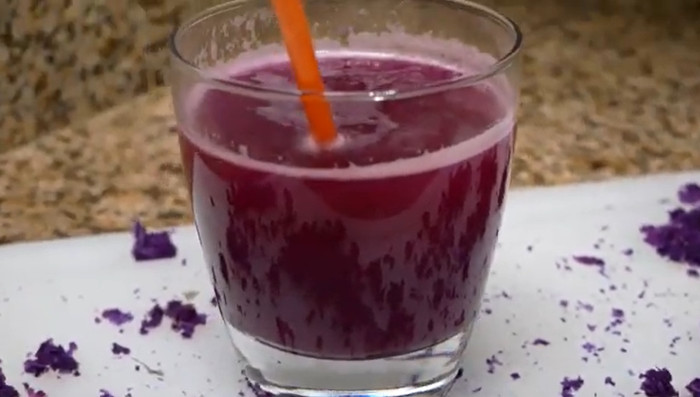
Instructions:
These instructions guide you through the simple process of preparing Red Cabbage Juice
- Prepare Ingredients: Wash and chop the red cabbage, apples, and carrots. Peel and seed the lemon, and grate the ginger. Wash the mint leaves.
- Juice the Ingredients: In a juicer, add the red cabbage, apples, carrots, lemon, ginger, and mint leaves. Juice them together until smooth.
- Adjust Consistency: If the juice is too thick, you can add water to reach your desired consistency.
- Strain if Needed: If you prefer a smoother juice, you can strain it to remove any remaining pulp.
- Chill and Serve: Pour the juice over ice cubes in a glass, or chill in the refrigerator before serving.
- Garnish: Optionally, garnish with a sprig of mint or a slice of lemon.
- Enjoy: Sip and enjoy your refreshing and nutritious Red Cabbage Juice!
How to get more fiber?
Getting more fiber in your diet is not just about what you eat but also how you prepare it. From the choice of juicer to the ingredients and preparation methods, these strategies can help you maximize the fiber content in your juices and overall diet
- Use a Cold Press Juicer: It retains more soluble fiber in the juice.
- Blend Whole Fruits: Instead of juicing, blend whole fruits to keep both soluble and insoluble fiber.
- Add Pulp Back: Mix some of the pulp back into the juice for added insoluble fiber.
- Include High-Fiber Ingredients: Use fruits, vegetables, nuts, and seeds that are rich in fiber.
- Add Ground Flaxseeds or Chia Seeds: These seeds are rich in dietary fiber and can be mixed into the juice.
- Use a Hand-Juicer for Citrus Fruits: It allows more pulp through, increasing soluble fiber.
- Choose the Right Strainer: Using a “smoothie or coarse” strainer can introduce more pulp or insoluble fiber.

- Eat Whole Fruits and Vegetables: Alongside juicing, consume whole fruits and vegetables to meet daily fiber needs.
- Avoid Over-Straining: Don’t strain the juice too much; some particle matter in the juice contains soluble fiber.
- Incorporate Leafy Greens: Spinach, kale, and other leafy greens are excellent sources of fiber.
Can juices with fiber help to relieve constipation?
Yes, juices with fiber can indeed help to relieve constipation. Fiber, especially soluble fiber, absorbs water and forms a gel-like substance in the digestive tract. This softens the stool and makes it easier to pass. Juices made with whole fruits and vegetables, or with pulp added back, retain more of this beneficial fiber. Cold press juicers, in particular, are effective in preserving soluble fiber in the juice.
Including ingredients like leafy greens, flaxseeds, or chia seeds can further enhance the fiber content. It’s essential to balance juice intake with whole foods to ensure a well-rounded fiber intake. While juices with fiber can be a helpful part of a diet to alleviate constipation, they should be consumed as part of a balanced diet rich in various fiber sources.
Benefits of high-fiber juice:
High-fiber juices offer a wide array of benefits, making them a valuable addition to a balanced and healthy diet.
- Digestive Health Improvement: High-fiber juice helps in digestion by adding bulk to the stool, aiding in regular bowel movements.
- Weight Management: The fiber content in juice can increase feelings of fullness, reducing overall calorie intake.
- Blood Sugar Control: Soluble fiber in juice can slow down sugar absorption, helping to stabilize blood sugar levels.
- Cholesterol Reduction: Certain fibers found in fruits and vegetables can bind to cholesterol, aiding in its removal from the body.
- Enhanced Hydration: Juices with high fiber content provide hydration along with nutrients, supporting overall health.
- Increased Nutrient Intake: High-fiber juices made from whole fruits and vegetables retain more vitamins and minerals.
- Versatility in Diet: They offer a convenient way to increase daily fiber intake, especially for those who struggle to consume enough whole fruits and vegetables.
- Supports Heart Health: Regular consumption of high-fiber juice may contribute to heart health by improving cholesterol levels and reducing blood pressure.
- Cancer Prevention: Some studies suggest that dietary fiber may play a role in reducing the risk of certain types of cancer.
- Eco-friendly Option: Using whole fruits and vegetables in juicing reduces waste, making high-fiber juicing an environmentally conscious choice.
Does juicing remove fiber?
Juicing does often remove a significant portion of fiber, especially the insoluble type found in fruit and vegetable skins and seeds. Traditional juicing methods extract the liquid and leave behind the pulp, where much of the fiber resides. However, not all fiber is lost. Soluble fiber, which dissolves in water, usually remains in the juice, providing some benefits.
For those looking to retain more fiber in their juices, blending whole fruits and vegetables or using a masticating juicer that crushes and grinds the produce can be effective. These methods preserve more of the fiber content, offering a more nutritious beverage. The choice between traditional juicing and these fiber-preserving methods depends on individual preferences and nutritional needs.
Side effects of drinking juice:
These side effects don’t mean that juices are inherently bad, but moderation and awareness of these potential issues can help you enjoy them as part of a balanced diet.
- Sugar Content: Many fruit juices contain high levels of sugar, which can lead to weight gain and dental issues if consumed excessively.
- Calorie Intake: Juices can be calorie-dense, contributing to an increased daily calorie intake, potentially leading to weight gain.
- Lack of Fiber: Traditional juicing often removes fiber, which can reduce the feeling of fullness and may lead to overeating.
- Blood Sugar Spikes: Without fiber to slow absorption, sugars in juice can cause rapid spikes in blood sugar levels, particularly concerning those with diabetes.
- Potential Allergens: Some juices may contain allergens or interact with medications, causing unexpected reactions.
- Acidic Nature: Citrus and other acidic juices can erode tooth enamel over time, leading to dental problems.
- Digestive Issues: Certain juices, like prune or cherry juice, can have a laxative effect, leading to diarrhea if consumed in large quantities.
- Interaction with Medications: Some juices, such as grapefruit juice, can interact with medications, altering their effectiveness.
- Expense: High-quality, fresh juices can be expensive, impacting your budget if consumed regularly.
- Potential Contamination: Improperly washed fruits and vegetables can lead to contamination with bacteria or pesticides in the juice.
Wrapping up:
High-fiber juices offer a myriad of benefits, from aiding digestion to potentially relieving constipation. However, the juicing process can sometimes remove essential fiber, and there are potential side effects to consider, such as sugar content and interactions with medications. The preparation of various juices, like Spinach Cucumber Juice or Kale Green Juice, requires specific ingredients and instructions, and the right equipment can enhance the juicing experience.
Incorporating high-fiber juices into a balanced diet can be a nutritious choice, but awareness of the potential pitfalls is key. Moderation, attention to ingredient quality, and understanding the role of fiber in juice can lead to a more informed and healthy approach to this popular beverage. Whether for taste, health, or dietary needs, high-fiber juices can be a valuable addition to your diet when consumed thoughtfully.
FAQs:
Which fruit has the most fiber?
In the world of fiber-rich fruits, pears stand out as a top contender. A medium-sized pear can contain up to 6 grams of fiber, more than most other fruits. This makes pears an excellent choice for those looking to increase their fiber intake. Including a pear in your daily diet can contribute to digestive health and provide a satisfying, sweet treat that’s packed with nutritional benefits.
Does apple juice count as fiber?
Apple juice, while delicious and refreshing, doesn’t typically count as a significant source of fiber. The juicing process removes most of the fiber found in whole apples, leaving behind mainly sugars and liquids. If you’re aiming to increase your fiber intake, it’s best to consume whole apples with the skin on, as that’s where the majority of the fiber is located. Whole apples provide a crunchy, satisfying snack that contributes to a healthy diet.



